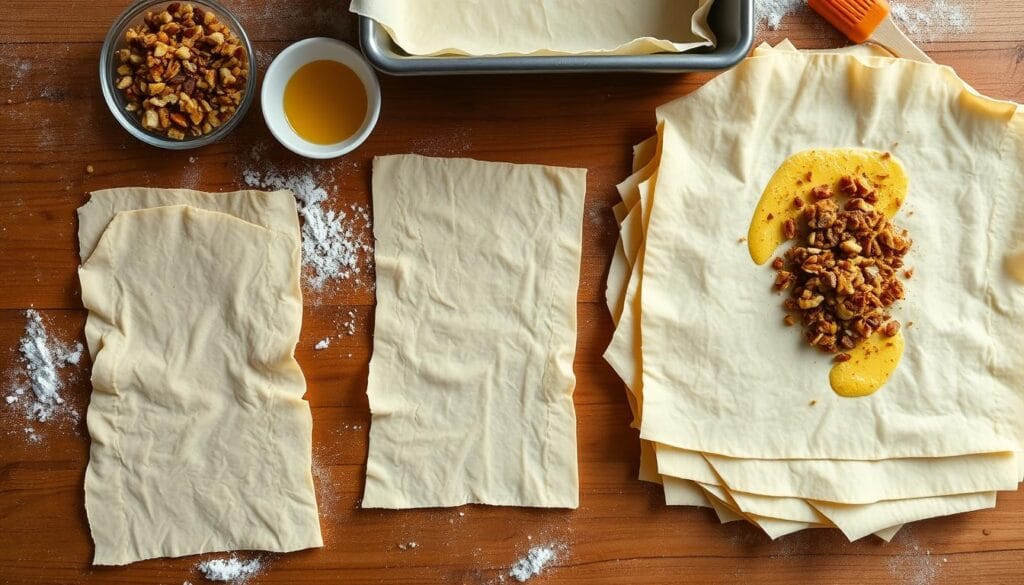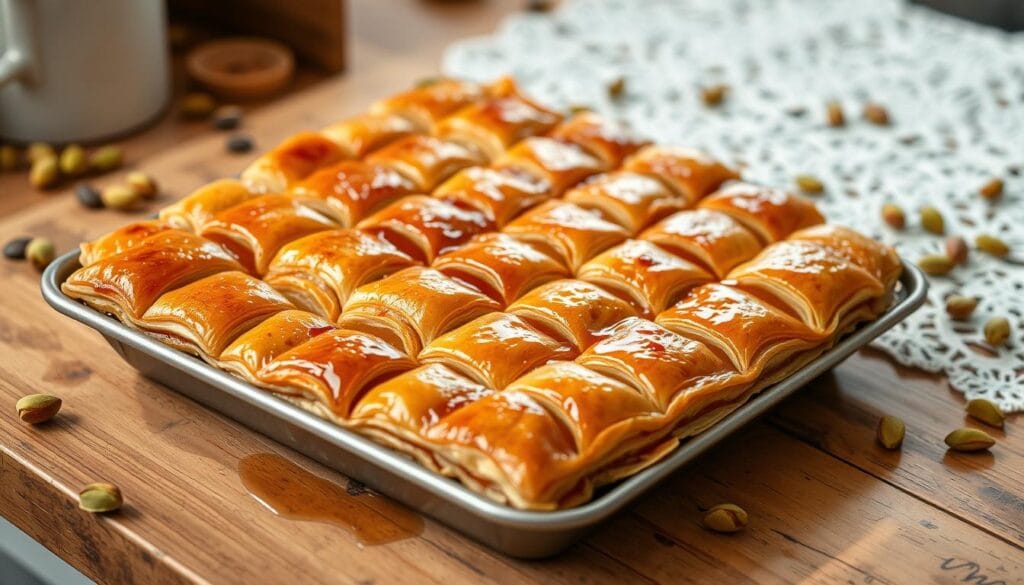Table of Contents
As I hold the warm, crisp slice of baklava, the aroma of nuts, spices, and honey fills my senses. It takes me to Istanbul’s bustling markets or Athens’ cozy cafés. This Middle Eastern pastry brings back memories and emotions, and I’m eager to share how to make it at home.
Making baklava is a labor of love, but the taste is worth it. Imagine biting into layers of flaky, buttery phyllo dough. It’s filled with the crunch of pistachios, walnuts, and hazelnuts, all tied together by a sweet honey syrup. It’s a mix of flavors and textures that will make you want more.
Key Takeaways
- Baklava is a classic Middle Eastern dessert made with layers of flaky phyllo dough and a nutty filling.
- Authentic baklava recipes use a blend of nuts like pistachios, walnuts, and hazelnuts, plus spices like cinnamon and cloves.
- The key to perfect baklava is layering the phyllo dough with melted butter and the nut mixture, then baking until golden brown.
- Pouring a sweet honey syrup over the hot baklava is the final step, allowing the flavors to meld and the pastry to become irresistibly moist and flavorful.
- Baklava can be made ahead and stored for up to 2 weeks at room temperature or frozen for longer-term enjoyment.
What is Baklava?
Baklava is a sweet treat loved by many in the Middle East, Mediterranean, and worldwide. It’s made with layers of flaky phyllo dough. Inside, you’ll find a mix of crushed pistachios or other nuts, all sweetened with honey syrup. This dessert’s roots are in Turkish cuisine and Greek cuisine, tracing back to ancient times.
A Rich History and Diverse Variations
The term “baklava” entered English in 1650. Yet, its history goes back even further. It’s believed to have evolved from the Greek placenta cake, Medieval Persian lauzinaj, and Central Asian Turkic breads. A Turkish dessert called güllaç was documented in 1330, showing baklava’s long history.
Through the years, baklava has changed and spread, with many variations. In Algeria, it’s made with malsouka or warqa dough and almonds. Syria’s version has 24 layers of phyllo with pistachios or walnuts. Armenia’s pakhlava also uses phyllo, showing the dessert’s wide appeal.
“Baklava is a classic Middle Eastern and Mediterranean dessert that has captivated taste buds for centuries.”
Ingredients for Homemade Baklava
To make authentic homemade baklava, you need a few key ingredients. The base is flaky phyllo dough, which gives it a crisp texture. The nut mix includes pistachios, walnuts, and hazelnuts, with sugar, cinnamon, and cloves for flavor.
The honey syrup is what holds it all together. It’s made with water, sugar, honey, lemon juice, and sometimes orange extract and cloves. This syrup adds a sweet, fragrant touch.
The Ingredients:
- Phyllo Dough: A package of thawed phyllo pastry sheets, typically 16 oz (450g).
- Nut Mixture: 1 lb (450g) of finely chopped nuts, such as pistachios, walnuts, and hazelnuts, along with 1/2 cup (100g) of granulated sugar, 1 tsp ground cinnamon, and 1/2 tsp ground cloves.
- Honey Syrup: 1 cup (240ml) of water, 1 cup (200g) of granulated sugar, 1/2 cup (120ml) of honey, 2 tbsp (30ml) of lemon juice, and optionally 1 tsp of orange extract and 2-3 whole cloves.
With these ingredients, you’re ready to make a delicious homemade baklava. It’s sure to impress anyone who tries it.
Preparing the Honey Syrup
To make the perfect honey syrup for homemade baklava, follow a few easy steps. Start by mixing 1 cup of sugar and 1 cup of water in a medium saucepan. Heat it over medium-high, stirring now and then, until the sugar dissolves.
After the sugar dissolves, add 1 1/4 cups of honey, 2 tablespoons of fresh lemon juice, and a pinch of salt (about 1/4 teaspoon). Let it boil, then lower the heat and simmer for about 25 minutes. Stir occasionally until it thickens a bit.
For more flavor, you can add a few drops of orange extract or a couple of whole cloves to the syrup. Once it cools down completely, it’s ready to drizzle over your freshly baked baklava.
| Ingredient | Quantity |
|---|---|
| Granulated Sugar | 1 cup |
| Water | 1 cup |
| Honey | 1 1/4 cups |
| Lemon Juice | 2 tablespoons |
| Salt | 1/4 teaspoon |
| Orange Extract (optional) | A few drops |
| Whole Cloves (optional) | 2-3 |
The honey syrup can be made ahead of time and stored in the fridge for up to 4 days. This makes assembling your baklava easy. Just remember to let it cool completely before pouring it over the pastry.
Making the Nut Mixture
To make the nut filling for homemade baklava, you’ll need to mix pistachios, walnuts, and hazelnuts in a food processor. Chop the nuts finely but not into a paste. This ensures your baklava has a crunchy texture.
Begin by measuring 1 lb (454g) of raw nuts. Use a mix of pistachios and walnuts in equal parts. Pulse the nuts in batches until they’re chopped but still have some texture. Avoid overprocessing to prevent a nut butter consistency.
After chopping the nuts, move them to a large bowl. Add 1/3 cup (70g) of sugar, 1/2 teaspoon of ground cinnamon, and a pinch of ground cloves. Mix well to spread the seasonings evenly in the baklava nut mixture.
| Ingredient | Quantity |
|---|---|
| Pistachios | 227g (2 cups) |
| Walnuts | 227g (2 cups) |
| Sugar | 70g (1/3 cup) |
| Ground Cinnamon | 1/2 teaspoon |
| Ground Cloves | Pinch |
This seasoned baklava nut mixture will be layered with phyllo dough. It creates the unique taste and texture of this Turkish dessert.
Preparing the Phyllo Dough
Working with phyllo dough for homemade baklava can be tricky. But, with the right steps, you can get perfect results. Start by carefully unrolling the thawed pastry and placing it between two clean, dry towels. This keeps the phyllo from drying out and becoming too brittle.
Phyllo dough comes in packages with about 20 sheets. Each sheet is very thin and can tear easily. Covering the phyllo between towels helps. This way, you can brush each layer with butter or oil before adding the next and your nut filling.
To work with phyllo well, thaw it slowly and keep it covered. Follow the package’s thawing instructions, which might take hours or overnight in the fridge. Once thawed, unroll the sheets carefully. Work fast to assemble your baklava before the phyllo dries out.
With patience and care, you can master phyllo dough. This way, you’ll make homemade baklava that’s both flaky and rich in flavor.
Assembling the baklava
To make the layers of homemade baklava, start by greasing a 9×13 inch baking pan with butter. Then, layer the phyllo sheets one by one. Brush each sheet with butter before adding the next. Do this until you have 5-6 layers.
Now, add the nut mixture. Spread about 1 1/4 cups of chopped nuts (half pistachios, half walnuts) over the layers. Sprinkle a bit of cinnamon and cardamom for extra taste.
- Keep layering 5-6 sheets of phyllo, brushing each with butter, and then add the nut mixture.
- Keep going until all ingredients are used up. Finish with a layer of phyllo brushed with butter.
- It helps to keep track of the layers to make sure the nut mixture is spread evenly.
For perfect baklava assembly, work fast and keep the phyllo moist. Brush the butter lightly to keep the layers flaky and distinct.

With patience and care, you’ll make a stunning baklava. It’s okay if it’s not perfect. The beauty of baklava lies in its layers and flavors.
Cutting and Baking the baklava
Before baking, it’s time to cut the baklava into diamond shapes. Use a sharp knife to slice it about 1/2-inch deep. This makes the baklava cutting pattern clear and helps with clean slices after baking.
Now, let’s bake it to golden brown perfection. Preheat your oven to 300°F (150°C). Place the baklava inside and bake for 45 minutes to an hour. Watch it closely until the top is golden brown and a skewer comes out clean.
| Ingredient | Amount |
|---|---|
| Walnuts | 300-400 grams |
| Sugar for Syrup | 5 cups |
| Water for Syrup | 3 1/2 cups |
| Syrup Boiling Time | 10-15 minutes |
| Baklava Baking Temperature | 170°C (preheated) |
| Baklava Baking Time | 1 hour 15 minutes |
To get the perfect baking baklava texture, start at a high temperature. Then, lower it slightly towards the end. This makes the outside crisp while keeping the inside tender and flaky.
“The diamond shapes of traditional baklava not only look stunning, but also create the perfect bite-sized pieces for easy serving and enjoying.”
Pouring the Honey Syrup
When your homemade baklava comes out of the oven, it’s time to add the cooled baklava honey syrup. This step makes sure the syrup soaks into the flaky layers. It creates a sweet and balanced baklava. You’ll hear a sizzling sound when the syrup meets the hot baklava.
The syrup recipe is simple. It includes water, sugar, honey, and a bit of lemon juice. Simmering these for 25 minutes makes a fragrant syrup. This syrup turns your baklava into a culinary masterpiece.
- Start by mixing 1 cup of water, 1 cup of sugar, 1 cup of honey, and 2 tablespoons of lemon juice in a saucepan.
- Boil the mixture, then lower the heat and simmer for 25 minutes. Stir occasionally until it thickens slightly.
- After removing from heat, let the baklava honey syrup cool for 20 minutes. This allows the flavors to blend.
Once your baklava is done, pour the warm baklava honey syrup over it. Use a ladle or spoon to cover every part of the pastry. This makes the baklava sweet, moist, and irresistible. Your guests will love it.
Pour the baklava honey syrup over the hot pastry right after baking. This ensures the syrup absorbs well and keeps the baklava moist. The sizzling and aroma are a preview of the delicious baklava to come.
Letting the baklava Cool and Absorb the Syrup
After pouring the fragrant honey syrup over the freshly baked baklava, it’s crucial to let it cool completely before serving. This cooling process is key to achieving the perfect texture for your homemade baklava.
As the baklava cools, uncovered and at room temperature, the flaky phyllo layers absorb the sweet syrup. This creates a delightful balance of textures. The outer pastry stays crisp, while the inner layers soften and become rich with honey.
The recommended cooling time for baklava is around 4 to 6 hours, or even overnight if you can. The longer it sits, the better it gets. The flavors meld, and the syrup fully incorporates into the pastry.
During the baklava cooling process, the syrup absorption transforms the texture of the dessert. The outer layers stay crisp, while the inner layers soften and soak up the honey’s sweet flavor.
“The key to perfect baklava is allowing it to cool and soak up the syrup for several hours, or even overnight. This ensures the layers are perfectly balanced in texture and taste.”

So, be patient and let your homemade baklava rest after baking. The rewards of a well-executed baklava cooling and syrup absorption process will be evident in the texture and flavor of your delectable pastry.
baklava Variations and Serving Suggestions
The classic baklava recipe uses pistachios, walnuts, and hazelnuts. But, you can try different nut options to find your favorite. Some people like using just walnuts or pistachios. Others add almonds or cashews for a unique taste.
To make your baklava look and taste great, try garnishing it. You can sprinkle chopped nuts or drizzle melted chocolate on top. Baklava is perfect as a dessert, a sweet snack, or with coffee or tea.
| Baklava Variation | Key Ingredients | Distinctive Features |
|---|---|---|
| Pistachio Baklava | Pistachios, sugar, lemon juice, water | Standard type with a soaking mixture |
| Chocolate Baklava | Hazelnuts, chocolate-hazelnut spread, bittersweet chocolate | Incorporates chocolate for a unique twist |
| Kuru Baklava | Phyllo dough, sugar coating | Swaps syrupy coating for a dense sugar coating |
| Havuç Dilim Baklava | Pistachios, buttery flavors | Sliced in triangles with a more buttery taste |
| Cevizli Baklava | Walnuts, cinnamon, sugar, vanilla | Highlights a walnut filling with added spices |
Baklava is very versatile. You can play with nut options and garnishes to make it your own. This way, you can enjoy a baklava experience that’s just right for you.
“Baklava is a versatile dessert that can be easily customized to suit individual tastes and preferences.”
Storing and Freezing baklava
Baklava is a delightful dessert that can be enjoyed long after it’s been freshly baked. Whether you’re looking to store your homemade baklava for future indulgence or want to freeze it for extended preservation, there are a few tips to keep in mind.
Storing Baklava at Room Temperature: Freshly baked baklava can be stored at room temperature, covered with a clean tea towel, for up to 2 weeks. This method helps maintain the pastry’s crisp texture and rich flavors. However, it’s important to note that baklava should not be stored at room temperature for more than 5 days, as it may dry out or become stale.
Refrigerating Baklava: For longer-term storage, you can keep baked baklava in the refrigerator for up to 2 weeks. The cooler temperature helps preserve the delicate layers and prevents the pastry from drying out. When ready to serve, let the baklava sit at room temperature for a few hours to allow the flavors to come back to life.
Freezing Baklava: To extend the shelf life of your baklava, you can freeze it for up to 4 months. Wrap individual portions or the entire pan tightly in plastic wrap or aluminum foil, then place in a freezer-safe container or bag. When ready to enjoy, thaw the baklava in the refrigerator overnight or at room temperature for a few hours. The crisp texture and flavor will be preserved, making frozen baklava a convenient and delicious option.
Remember, the key to successful baklava storage and baklava freezing is to keep the pastry well-protected from air and moisture. With proper handling and storage, you can savor the delightful flavors of this beloved dessert for weeks or even months to come.
Conclusion
This guide has given you all the info and steps to make real, homemade baklava in your kitchen. You now know how to handle phyllo dough, mix the right nut mixture, and make the best honey syrup. You’re ready to make this famous Middle Eastern dessert with ease.
Whether it’s for a big event or just a sweet moment, this recipe and tips will help you make perfect baklava. It’s a dessert loved worldwide, with roots in the Assyrian Empire and perfected in the Ottoman court.
Now, you can start your own baklava adventure. Try new nut mixes, flavors, and ways to present it. Enjoy the history and culture of baklava as you share it with loved ones. It’s a way to make memories and bring people together with this classic pastry.
FAQ
What is baklava?
Baklava is a classic dessert from the Middle East and Mediterranean. It has layers of thin, flaky pastry. These layers are filled with chopped nuts and sweetened with honey syrup.
What are the key ingredients for homemade baklava?
Homemade baklava needs phyllo pastry and a mix of nuts like pistachios, walnuts, and hazelnuts. It also requires sugar, cinnamon, and cloves. The syrup is made with honey, water, lemon juice, and sometimes orange extract and cloves.
How do you prepare the honey syrup for baklava?
Start by mixing sugar and water in a saucepan. Heat it, stirring now and then, until the sugar dissolves. Add honey, lemon juice, and optional ingredients like orange extract and cloves. Bring it to a boil, then simmer for 25 minutes.
How do you make the nut mixture for baklava?
Pulse pistachios, walnuts, and hazelnuts in a food processor until they’re finely chopped. Then, mix them with sugar, cinnamon, and a pinch of cloves in a bowl.
How do you handle the phyllo dough when making baklava?
When using phyllo dough, thaw it as instructed. Then, unroll the sheets and place them between towels. This prevents the dough from drying out and breaking.
How do you assemble the baklava layers?
Start by brushing a baking pan with butter. Layer the phyllo sheets, brushing each with butter. Add a layer of nut mixture, then repeat. Finish with a layer of phyllo and butter.
How should you bake the baklava?
Cut the pastry into diamond shapes before baking. Bake in a preheated oven for 35 to 45 minutes. The top should be golden, and a skewer should come out clean.
How do you pour the honey syrup over the hot baklava?
Pour the cooled honey syrup over the hot baklava right after it comes out of the oven. This ensures the syrup is absorbed into the layers.
How long should you let the baklava cool before serving?
Let the baklava cool completely, uncovered, at room temperature. This is 4 to 6 hours or overnight. It allows the pastry to absorb the syrup perfectly.
Can you vary the nut mixture in baklava?
Yes, you can use different nuts in baklava. Try using just walnuts or pistachios, or add almonds or cashews for a twist.
How can you store and preserve homemade baklava?
Store homemade baklava at room temperature, covered, for up to 2 weeks. Freeze it for up to 4 months. Thaw in the fridge or at room temperature before serving.

